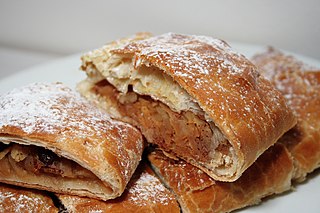 W
WApple strudel is a traditional Viennese strudel, a popular pastry in Austria, Bavaria, Czech Republic, Northern Italy and in many other countries in Europe that once belonged to the Austro-Hungarian Empire (1867–1918).
 W
WA babka is a sweet braided bread or cake which originated in the Jewish communities of Poland and Ukraine. It is popular in Israel and in the Jewish diaspora. It is prepared with a yeast-leavened dough that is rolled out and spread with a filling such as chocolate, cinnamon, fruit, or cheese, then rolled up and braided before baking.
 W
WBialy, a Yiddish word short for biały or bialystoker kuchen, from the city of Białystok in Poland, is a small roll that is a traditional dish in the Polish Ashkenazi Jewish cuisine.
 W
WA blini or, sometimes, blin, is a Russian pancake traditionally made from wheat or buckwheat flour and served with smetana, tvorog, butter, caviar and other garnishes. Blini are among the most popular and most-eaten dishes in Russia.
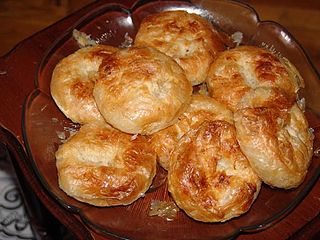 W
WBoyoz is a Turkish pastry of Sephardic Jewish origin, associated with İzmir, Turkey, which is practically the only city where it is prepared for commercial purposes and follows the original recipe. As such, in the eyes of Smyrniots boyoz became a symbol of their hometown or of their longing for it when away. The most widely preferred boyoz is plain, without addition of meat or cheese or spinach stuffings, and as cooked by a handful of master boyoz bakers in İzmir.
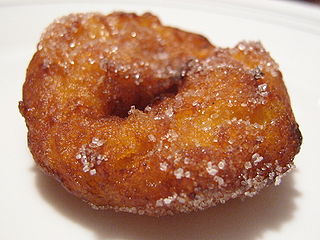 W
WA buñuelo is a fried dough fritter found in Spain, Latin America, Israel, and other regions with a historical connection to Spaniards or Sephardic Jews, including Southwest Europe, the Balkans, Anatolia, and other parts of Asia and North Africa. Buñuelos are traditionally prepared at Christmas, Ramadan, and among Sephardic Jews at Hanukkah. It will usually have a filling or a topping. In Mexican cuisine, it is often served with a syrup made with piloncillo.
 W
WChallah is a special bread of Ashkenazi Jewish origin, usually braided and typically eaten on ceremonial occasions such as Shabbat and major Jewish holidays. Ritually-acceptable challah is made of dough from which a small portion has been set aside as an offering. Challah may also refer to the dough offering, and any bread that is made for Shabbat, or from which an offering is taken.
 W
WCheesecake is a sweet dessert consisting of one or more layers. The main, and thickest, layer consists of a mixture of a soft, fresh cheese, eggs, and sugar. If there is a bottom layer, it most often consists of a crust or base made from crushed cookies, graham crackers, pastry, or sometimes sponge cake. Cheesecake may be baked or unbaked.
 W
WCoffee cake may refer to a sponge cake flavored with coffee or, in the United States, a sweet cake intended to be eaten with coffee or tea. A coffee-flavored cake is typically baked in a circular shape with two layers separated by coffee butter icing, which may also cover the top of the cake. Walnuts are a common addition.
 W
WAn everything bagel is a type of bagel baked with a large variety of toppings. The exact ingredients vary depending on the vendor, but toppings commonly include poppy seeds, sesame seeds, onion flakes, garlic flakes, sunflower seeds, caraway seeds, pretzel salt, and black pepper. The bagels are made with regular dough, and the name does not refer to any fillings.
 W
WFlourless chocolate cake is a dense cake made from an aerated chocolate custard. The first documented form of the cake was seen in Ferrara, Italy, though some forms of the cake have myths surrounding their origins. The dessert contains no gluten which makes it acceptable for those with celiac disease, gluten-free diets, and during religious holidays in which gluten and grains are not permitted.
 W
WGermknödel is a fluffy yeast dough dumpling (knödel), filled with spiced plum jam and served with melted butter and a mix of poppy seeds and sugar on top. It is occasionally - even though less traditional - served with vanilla cream sauce instead. It is a culinary specialty of Austria and Bavaria. The dish is served both as a dessert and as a main course.
 W
WJachnun or Jahnun is a Yemenite Jewish pastry, originating from the Adeni Jews, and traditionally served on Shabbat morning. Yemenite Jewish immigrants have popularized the dish in Israel.
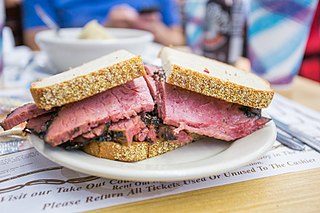 W
WJewish rye bread refers to a type of rye bread commonly made in Jewish communities. Due to the diaspora of the Jews, there are several geographical variations of the bread. The bread is sometimes called sissel bread or cissel bread, as sissel means caraway seed in Yiddish.
 W
WA knish is a traditional Ashkenazi Jewish snack food consisting of a filling covered with dough that is typically baked or sometimes deep fried.
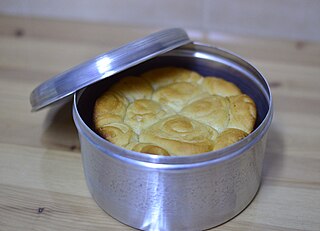 W
WKubaneh Hebrew: כֻּבַּאנֶה is a traditional Yemenite Jewish bread that is popular in Israel. Kubaneh is traditionally baked overnight to be served for Shabbat morning accompanied by haminados, and resek agvaniyot.
 W
WLahoh, also laḥūḥ, meaning "flat" in Arabic from the Arabic root word "lowh" ("لوح"), is a spongy, flat pancake-like bread that originated from Somalia. It is a type of flat bread eaten regularly in Somalia, Somaliland, Djibouti, Ethiopia and Yemen, and Yemenite Jewish immigrants have popularized the dish in Israel. It is called Laxoox/Lahoh or Canjeero in Somaliland, Somalia and Djibouti, and called Lahoh/Lahuh in Yemen, respectively.
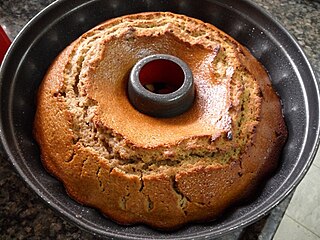 W
WLekach is a honey-sweetened cake made by Jews, especially for the Jewish holiday of Rosh Hashanah. Known in Hebrew as ʿougat dvash the word lekach is Yiddish. Lekach is one of the symbolically significant foods traditionally eaten by Ashkenazi Jews at Rosh Hashanah in hopes of ensuring a sweet New Year.
 W
WA macaroon is a small cake or cookie, typically made from ground almonds, coconut or other nuts, with sugar and sometimes flavorings, food coloring, glacé cherries, jam or a chocolate coating – or a combination of these or other ingredients. Some recipes call for sweetened condensed milk. Macaroons are sometimes baked on edible rice paper placed on a baking tray.
 W
WMalawach or Malawax,, is a flatbread that is traditional in Somali cuisine. It was brought to Israel by Yemenite Jews who adopted from Somalis in Somalia. Malawach resembles a thick pancake but consists of thin layers of puff pastry brushed with oil or fat and cooked flat in a frying pan. It is traditionally served with hard-boiled eggs, zhug, and a crushed or grated tomato dip. Sometimes it is served with honey.
 W
WMandelbrot, with a number of variant spellings, and called mandel bread or kamish in English-speaking countries and kamishbrot in Ukraine, is a type of cookie found in Ashkenazi Jewish cuisine and popular amongst Eastern European Jews. The Yiddish word mandlbroyt literally means almond bread, a reference to its common ingredient of almonds. It is typically formed by baking a loaf which is then cut into small slabs and twice-baked in order to form a crunchy exterior. The cookies were popular in Eastern Europe among rabbis, merchants and other itinerant Jews as a staple dessert that kept well.
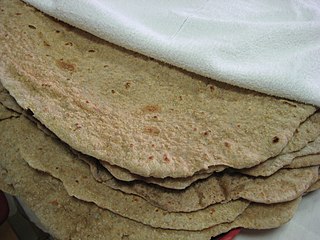 W
WMarkook bread, also known as khubz ruqaq, shrak, khubz rqeeq, mashrooh, and saj bread, is a kind of Middle Eastern unleavened flatbread common in the Levant and the Arabian peninsula. It is baked on a convex metal griddle or in a tannour.
 W
WMatzah pizza is a type of pizza made by baking a piece of matzo that has been topped with sauce and cheese. Because Jewish law prohibits the consumption of leavened bread during Passover, some individuals use matzo as a substitute for traditional pizza crusts during the holiday.
 W
WMatzo lasagna, also known as matzagna, is a Jewish type of lasagna made by layering sheets of matzo with typically a tomato or a bechamel sauce and various cheeses. It originated from the Italian Jews and is popular in Israel, the United States, and the rest of the diaspora. It is similar to the traditional Sephardic Jewish dish mina; though the fillings differ as mina is typically made with meat or a spinach and feta filling while matzo lasagna is made with sauce and cheese.
 W
WMofletta is a Maghrebi Jewish pancake traditionally eaten during the Mimouna celebration, the day after Passover.
 W
WMohn bar, also known as mon bar, or poppy seed bar, is an Ashkenazi Jewish baked good consisting of a shortcrust pastry base with a sweet mohn filling, and a streusel/crumb topping. It may be commonly found at kosher bakeries and Jewish delis across the United States.
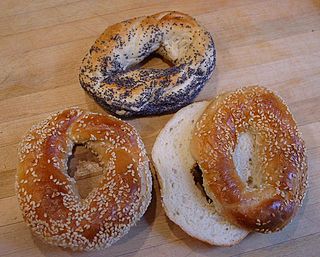 W
WThe Montreal-style bagel or Montreal bagel, is a distinctive variety of handmade and wood-fired baked bagel. In contrast to the New York-style bagel, which also contains sourdough, the Montreal bagel is smaller, thinner, sweeter and denser, with a larger hole, and is always baked in a wood-fired oven. It contains malt, egg, and no salt, and is boiled in honey-sweetened water before being baked.
 W
WMouna, also known as Mona is an Algerian Jewish sweet bread of Sephardi origin, similar to challah, kubaneh or brioche, that is traditionally consumed for the Jewish holidays of Mimouna and Shabbat, which is commonly found today in France, and Israel, and has a sweet taste enriched with oil and eggs and often contains anise, sesame, orange, or other citrus.
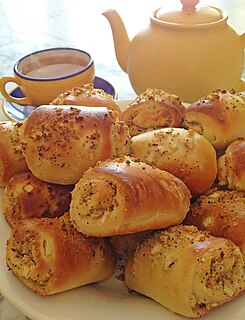 W
WOnion rolls are a roll of Ashkenazi Jewish origin similar to a bun, that is made of a soft, slightly sweet dough similar to challah, containing dried onions throughout which create its signature flavor. It is often topped with dried onions, and occasionally poppy seeds. Onion rolls are popular in the Jewish world.
 W
WPastelitos de hoja is a Sephardic Jewish pastry originating in the Jewish community that formerly existed in Tetouan, Morocco.
 W
WA pizza bagel is a bagel with pizza toppings, originating in the United States.
 W
WPoppy seed paste, also known as mohn is a common ingredient in Jewish pastries and desserts, and is made from ground poppy seeds and additional sweeteners. Examples of pastries featuring the filling include mohn kichel, babka, and, most famously, hamantashen. In Jewish cuisine, the filling is traditionally referred to as mohn, the word for poppy in both Yiddish as well as German. Poppy seed-filled pastries are particularly associated with the holiday of Purim
 W
WPumpernickel is a typically heavy, slightly sweet rye bread traditionally made with sourdough starter and coarsely ground rye. It is sometimes made with a combination of flour made from rye as well as whole rye grains.
 W
WRugelach is a filled pastry product originating in the Jewish communities of Poland. It is popular in Israel, commonly found in most cafes and bakeries. It is also a popular treat among Jews in the diaspora.
 W
WIn baking and pastry making, streusel is a crumbly topping of flour, butter, and sugar that is baked on top of muffins, breads, pies, and cakes. Some modern recipes add spices and chopped nuts. The mixture can also be layered or ribboned in the middle of a cake.
 W
WStreuselkuchen, also known in English-speaking countries as crumb cake, is a cake made of yeast dough covered with a sweet crumb topping referred to as streusel. The main ingredients for the crumbs are sugar, butter, and flour, which are mixed at a 1:1:2 ratio. It is popular in German, Polish and Ashkenazi Jewish cuisines.
 W
WA strudel is a type of layered pastry with a filling that is usually sweet. It became popular in the 18th century throughout the Habsburg Empire. Strudel is part of Austrian cuisine but is also common in other Central European cuisines. In Italy it has PAT recognition, which classifies it as a traditional agri-food product.
 W
WSufganiyah is a round jelly doughnut eaten in Israel and around the world on the Jewish festival of Hanukkah. The doughnut is deep-fried in oil, filled with jam or custard, and then topped with powdered sugar. The doughnut recipe originated in Europe in the 1500s and by the 1800s was known as a Berliner in Germany. Polish Jews, who called it a ponchik, fried the doughnut in schmaltz rather than lard due to kashrut laws. The ponchik was brought to Palestine by Polish Jewish immigrants, where it was renamed the sufganiyah based on the Talmud's description of a "spongy dough".